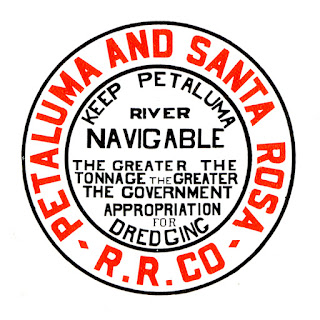Those interested in the West, or in electric traction, probably have heard of the Petaluma & Santa Rosa Railroad. If you haven’t heard of it, the two Northern California cities in its name should tell you its location. It was eventually controlled by its neighbor, the Northwestern Pacific, which by that time was owned by the Southern Pacific.
The P&SR began service in 1904, as a consolidation of several horse-drawn streetcar companies, and soon was electrified, using conventional overhead (the electrified commuter lines in adjoining Marin County used a third-rail system). There was freight service from the outset, though passenger service was the emphasis. The scheme for freight forwarding was to carry cargoes to Petaluma and load them onto a P&SR steamer, which would descend Petaluma Creek to San Francisco Bay, and deliver freight to the city of San Francisco.
Petaluma Creek was not only tidal, but shallow. Efforts to get federal funds for dredging were fruitless until the creek could be declared a navigable waterway. To help this along, the name was changed locally to the Petaluma River, and dredging did in fact become a regular occurrence (eventually federal approval was obtained for the name change). The railroad promoted this in one of its emblems of the day, meanwhile promoting its own usage of the river:
But as automobile usage increased through the 1920s, the P&SR lost more and more of its passenger traffic. In 1932, it would be purchased by the NWP. Shortly afterward, passenger service ended, though freight and steamer service continued. But the Golden Gate bridge further cut into the P&SR’s revenues as trucking increased, and in 1947, electric service ended. The wire came down, and a pair of GE 44-ton diesels took over the freight service. But as late as 1958, the P&SR still operated with its own locomotives.
(Incidentally, I learned a lot of this from knowing Fred Stindt, author of a two-volume history of the Northwestern Pacific, and a generous sharer of photographs.)
Knowing of the extensive shipment of Gravenstein apples from the Sebastopol area, much of it carried by the P&SR, along with some traffic in dried apples and apple products, my own layout can certainly be a recipient of such traffic. In particular, the San Francisco company, Garcia and Maggini, dealing in spices, dried fruit, coffee and other food products, had a plant in Sebastopol for drying apples. Below is a view of that plant in P&SR’s streetcar days (Tom Gray collection, courtesy Fred Stindt).
Obviously fresh apples would be mostly shipped in PFE refrigerator cars, given P&SR’s ownership connection to SP, but dried fruit might travel otherwise. Quite a few years ago I decided to try and model a P&SR box car, based on this photo of an NWP car (Fred Stindt collection):
This is a 37-foot car, and I immediately thought of the broadly similar Model Die Casting “old time” box car, which resembles this photo. And at about the same time, I found a pair of cardboard P&SR car sides at a train show. Likely someone reading this list will know the source, but I didn’t, then or now (Red Ball?). Anyway, I filed an MDC body smooth and glued on the card sides, then added wire grab irons and a scribed wood door. I ended up with this model:
Unfortunately, there were two things I didn’t know at that time. First, the paint scheme and car number of these cardboard sides were no coincidence; they were taken from a prototype photo, a copy of which I later got from Fred. It does have a plain door, like my model, but has a truss-rod underframe, not a “fishbelly” steel underframe.
Second, even as early as 1940, the P&SR no longer used its freight equipment in interchange, relying on big brothers NWP and SP for its car needs. So a P&SR car off home rails would really be an anachronism after World War II.
But would it? An old car, not meeting current interchange requirements, could be refused at any junction by a receiving railroad; but if SP and NWP cooperated with a movement of a P&SR box car, it would be possible for such a car to move away from home rails. In a time of car shortage, such a cooperation would certainly be possible (if unlikely). So perhaps this model will show up in an operating session on my layout one of these days, after all.
Tony Thompson





No comments:
Post a Comment